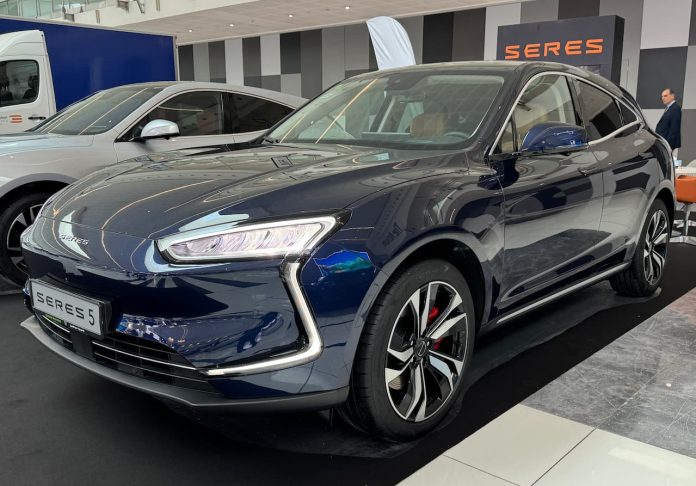Chinese auto brand Seres (you’d recall SF Motors, based in California, which it was known earlier as) has begun introducing electric models worldwide. This year, the company plans to deliver 50,000 cars outside China, and take that number to 500,000 units by 2030. Europe, the Middle East, and right-hand drive markets including the UK are on the radar.
A model of significance is the Seres 5, a mid-size electric SUV, which is spec’d to take on the Tesla Model Y. Last month, I got the chance to spend time with the Seres 5, and here are my impressions:
Design

The Seres 5 isn’t based on a dedicated EV platform, and is a conversion of the SF5 hybrid SUV. That said, I found its proportions quite interesting. Certain aspects are reminiscent of the Mercedes A-Class, where the sleek and aerodynamic body is characterized by flowing lines and a coupe-like silhouette.
The Seres 5 sports a distinctive front fascia marked by LED headlamps that link up to boomerang-shaped LED guides. The nose is similar to the gas vehicle, but the grille is shut off. Aero efficiency is further improved by flush door handles and sculpted doors and fenders, while the sloping roofline culminates in a subtle spoiler.


The design is nothing out of this world, but I found it stylish and inviting, particularly in this shade of dark blue metallic, which is marketed as ‘Sea Blue.’
Interior
The Seres 5’s interior was a pleasant surprise. The model I sat in was a dual-tone finish, with soft-touch surfaces and high-quality leather upholstery. The 12.3-inch digital instrument cluster and the 15.6-inch touchscreen infotainment system are the highlights, both offering excellent resolution, responsiveness, brightness and clarity. The car comes with two wireless smartphone chargers, and besides cavernous door pockets and glove compartment, the center console is hollowed-out to offer useful storage space for everyday items.


Ingress & front seats
At six feet tall, I found that getting in and out of the vehicle was easy, despite its sporty roofline.
When I sat in the driver’s seat, my first concern was the visibility. The Seres designers have gone for a stylish look with a rising shoulder line and coupe-style body, which does reduce rear visibility. However, the view from the front and sides was clear.


The two-spoke steering wheel, inspired by luxury models, is manually adjustable, and is covered with two different leather surfaces. My head had plenty of clearance from the glass roof, which lets a good amount of natural light into the vehicle. The Nappa leather seat was firm but provided good back support. However, I felt that the under-thigh support could be better.
The overall quality of the materials in the cabin was quite premium, though the hard plastic around the armrest could be improved to match the rest of the interior.


I liked the feel of the buttons and scrollers on the steering wheel, as well as the quality of the Head-up Display and digital cluster. However, I was not a fan of the Seres 5’s lack of physical controls for the infotainment and air conditioning, as everything is now part of the menu system.
Rear seat
In the second row, I had to be careful not to bump my head due to the sloping roofline. With the driver’s seat adjusted for my height, I had just enough legroom, but knee room was limited. The backrest felt a bit too upright, and the slightly raised knee position wasn’t very comfortable.


There is a recline function in the back seats, and there’s ample headroom, but the overall seating posture could be better.
Specifications
The Seres 5 has a length of 4,710 mm (185.4 inches), width of 1,930 mm (76 inches), and height of 1,620 mm (63.8 inches), with a wheelbase measuring 2,875 mm (113.2 inches). The front trunk (frunk) offers 67 liters (2.4 cu.ft) of storage, while the boot has a generous capacity ranging from 367 to 723 liters (13 to 25.5 cu.ft), depending on the configuration of the rear seats.

As per its global website, the Seres 5 is manufactured in three variants: 2WD Standard, 4WD Premium, and 4WD Flagship.
2WD Standard
The 2WD Standard variant is equipped with a rear-drive electric motor generating 220 kW (295 hp) of power and 420 Nm (310 lb-ft) of torque. It features an 80 kWh lithium iron phosphate (LFP) battery, offering a WLTP range of 500 km (310 miles). This variant accelerates from 0 to 100 km/h (62 mph) in 6.8 seconds and can be charged from 20% to 80% SOC in under 42 minutes using a fast-charger.
4WD Premium
The 4WD Premium variant employs a dual-motor 4WD system with a combined output of 430 kW (577 hp) and 940 Nm (693 lb-ft) of torque. It also uses an 80 kWh LFP battery, but the range drops slightly to 483 km (300 miles) due to the added weight and power. This variant boasts a 0 to 100 km/h (62 mph) time of 4 seconds and shares the same fast-charging time as the 2WD Standard.
4WD Flagship
The 4WD Flagship variant shares the same powertrain as the 4WD Premium, but it gets a larger 90 kWh semi-solid-state battery, increasing the WLTP range to 530 km (329 miles). This variant matches the 4-second 0-100 km/h (62 mph) time of the 4WD Premium and can be fast-charged from 20% to 80% SOC in under 51 minutes. All variants have a slow-charging time of lower than 7.5 hours to reach 90% SOC.
Price

The Seres 5 is available in select European markets. In Norway, it is priced at NOK 599,000 (USD 56,998).

An automobile engineer by training, I’ve analyzed the global car market since 2005, with a keen focus on EVs since 2008. My journey in online automotive publishing spans 16 years, during which I have reviewed cutting-edge automotive technologies and interviewed leading CEOs and vehicle developers from around the world.









